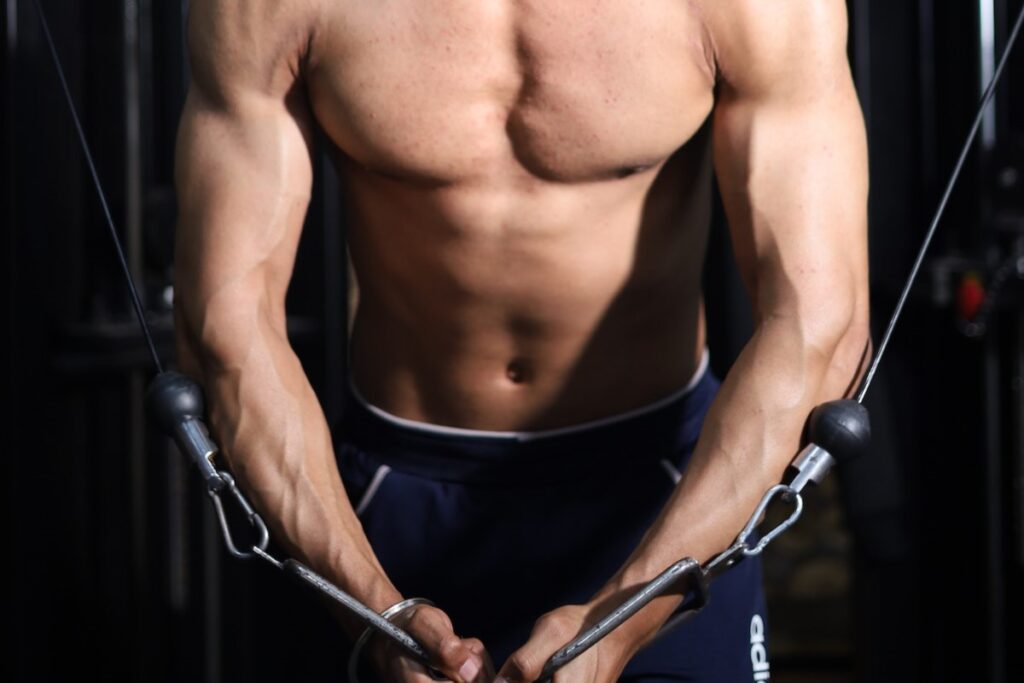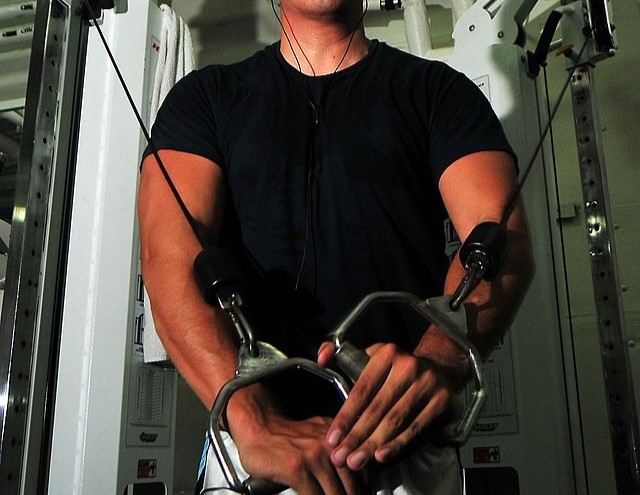Cable fly exercises are game-changers when it comes to building a powerful and defined chest. By targeting the lower chest muscles, these isolation exercises contribute to overall pectoral muscle development, ultimately enhancing chest strength and aesthetics.
In this article
- What are the muscles worked during lower chest cable flyes?
- What are the benefits of lower chest cable fly exercises?
- What are the different variations of lower chest cable fly exercises?
- How many sets and reps should you do?
- How do you combine lower chest cable flyes with other exercises?
- Frequently asked questions (FAQ)
- Final Word

In this blog post, we will delve into the benefits of using the cable fly for the lower chest, discuss the correct form and technique, and explore variations to spice up your workout routine. Additionally, we will provide guidance on incorporating this exercise into your workout plan and pairing it with complementary exercises.
What are the muscles worked during lower chest cable flyes?
When you’re doing lower chest cable flyes, you’re primarily working the sternal head of your pectoralis major, which is the lower part of your chest. This exercise is designed to target and isolate this area specifically.
In addition to the lower chest, you’re also engaging your anterior deltoids – the front part of your shoulders – and the biceps’ short head, albeit to a lesser extent. These muscles are involved in the movement and stabilization during the exercise.
What are the benefits of lower chest cable fly exercises?
Lower chest cable fly exercises offer several benefits that make them an excellent addition to your workout routine. Some key benefits include:
- Shoulder-friendly: Compared to bench presses and dips, lower chest cable exercises are more shoulder-friendly, reducing the risk of shoulder strain or injury.
- Constant tension: Cable exercises provide constant tension on the muscles, allowing you to focus on squeezing the muscle fibers and achieving a better pump.
- Large range of motion (ROM): The cable crossover fly, when adjusted to target the lower chest, stretches the chest from the start and takes you through a large ROM, which contributes to better hypertrophy potential.
Incorporating lower chest cable exercises into your workout routine can help you target and develop the lower chest muscles effectively, leading to improved chest strength and aesthetics.
[Related: 6 Yoga Strap Stretches That Will Soothe Your Muscle Tension]

What are the different variations of lower chest cable fly exercises?
There are several variations of the cable fly that target the lower chest. Some of these include:
1. Decline cable flyes
Performing the cable fly exercise on a decline bench helps isolate the lower chest muscles more effectively.
How to do it:
- Set the pulleys at the highest level (above your head) on the cable machine.
- Stand in the middle of the cable machine, grab a handle in each hand, and take a step forward to create tension in the cables. Lean forward slightly from your hips, keep your back straight, and have a slight bend in your knees for balance.
- Extend your arms out to the sides in line with your shoulders but slightly forward, in a wide arc. This is your starting position.
- Keeping a slight bend in your elbows, bring your hands down and towards each other in a smooth arcing motion. Your hands should meet below your chest. Contract your chest muscles as you perform this movement.
- Slowly reverse the motion, letting your arms arc back out to the sides and slightly upwards, until you’re back in the starting position. The return motion should be controlled, don’t let the weights just pull your arms back. Perform the desired number of repetitions.
Check out this video called “How to Do a Decline Cable Fly” from the “Howcast” Youtube channel.
2. High-to-low cable chest fly
With the pulleys set to a high position, perform the cable fly by pulling the cables in a downward arc toward the center of your body. This targets the lower portion of the pectoral muscles.
How to do it:
- Adjust the pulleys to the highest position on the cable machine. Select a light to moderate weight to start.
- Stand in the middle of the machine. Grab a handle in each hand, and step forward to create tension in the cables.
- Stand upright with a slight bend in your knees, and lean your torso slightly forward. Extend your arms out to your sides, in line with your shoulders. This is your starting position.
- With a slight bend in your elbows, pull the handles down and inwards in front of your body, focusing on squeezing your chest muscles. Your hands should meet below your chest.
- Slowly reverse the motion, controlling the movement, and allow your arms to extend back out to your sides, back to the starting position. Continue for your desired number of repetitions.
Check out this video called “How to: Cable Fly for Lower Chest (High to Low)” from the “Physique Development” Youtube channel.
3. Single-arm cable fly
This is performed with a cable fly in one arm at a time, focusing on maintaining proper form and isolating the lower chest muscles. This variation can help address imbalances and increase the intensity of the exercise.
How to do it:
- Adjust the pulley to chest height on a cable machine. Select a light to moderate weight to start.
- Stand to the side of the machine and grip the handle with the hand that’s furthest from the machine.
- Take a step away from the machine to create tension in the cable. Stand upright with a slight bend in your knees. Extend your arm out to your side, in line with your shoulder. Your palm should be facing forward. This is your starting position.
- With a slight bend in your elbow, pull the handle across your body to the other side, focusing on squeezing your chest muscles. Your hand should end up in front of the opposite side of your chest.
- Slowly reverse the motion, controlling the movement, and allow your arm to extend back out to the side, back to the starting position.
- Continue for your desired number of repetitions, and then switch sides to ensure balanced training on both sides.
Check out this video called “Single Arm Cable Chest Fly” from the “ShytownFitness” Youtube channel.
These variations can be incorporated into your workout routine to target the lower chest muscles from different angles and add variety to your training.
How many sets and reps should you do?
Depending on your fitness level, adjust the number of sets and reps you perform per week. For beginners, consider doing around 10 sets per week, while intermediate individuals might aim for around 15 sets per week. For decline cable chest fly, beginners can start with 3-4 sets per week, intermediates with 5-8 sets per week, and advanced individuals with 8-10 sets per week.
How do you combine lower chest cable flyes with other exercises?
Include cable fly variations and other lower chest exercises like decline bench presses and dips in your workout routine to target different areas of the lower chest. Remember to start with a weight that allows you to perform the exercise with proper form and gradually increase the weight as you become more comfortable with the movement.
Frequently asked questions (FAQ)
Got more questions about cable fly for the lower chest? Check out some commonly asked questions about this topic below.
Is it possible to target the lower chest specifically with cable fly exercises?
Yes, you can target the lower chest specifically with cable fly exercises by adjusting the pulleys to a higher position and focusing on the contraction of the lower chest muscles during the movement. Leaning slightly forward and maintaining proper form will also help isolate the lower chest muscles.
Can beginners perform cable fly exercises for the lower chest?
Absolutely! Beginners can perform the cable fly for the lower chest, but they should start with lighter weights and focus on mastering the proper form and technique. As they become more comfortable with the exercise, they can gradually increase their weight to challenge their muscles and promote growth.
How often should I perform cable fly for lower chest exercises in my workout routine?
It’s generally recommended to perform cable fly for lower chest exercises 1-2 times per week, as part of a balanced chest workout routine. This frequency allows adequate recovery time and helps prevent overtraining, while still providing enough stimulus for muscle growth and development.
Final Word
So, are you ready to incorporate the cable fly for the lower chest into your workout routine and start reaping the benefits? By focusing on proper form, technique, and frequency, you can effectively target the lower chest muscles, build strength, and achieve the sculpted chest you’ve always desired. If you found this article helpful, share it with a friend, and check out my full blog for more tips on chest exercises and overall fitness.
